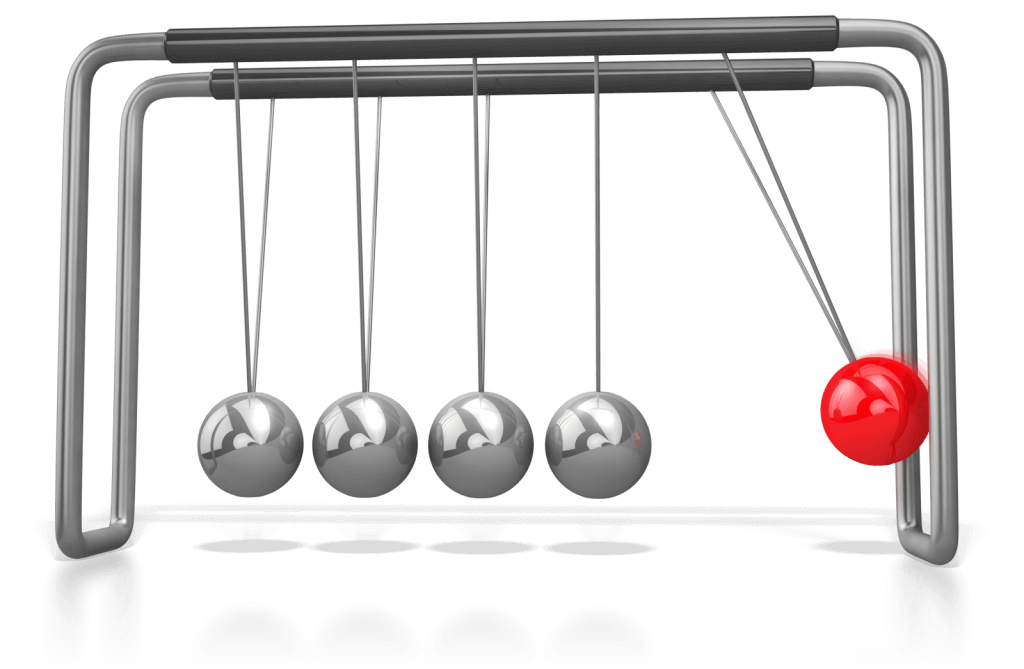Marketing budgeting is hard! How do you know what to spend?
Marketing is a major part of any business, big or small. But how do you know what your marketing budget should be? Who has the magic formula that will get the best results?
Like all things in business, there is no magic. Just time tested methods that will work if you work them. Marketing needs work and it’s critical for all businesses. But I am often told by businesses that they don’t have the time or money to market themselves. Here’s why that is a big mistake.
Marketing is about building momentum in your business. And momentum is much easier to sustain than starting and stopping. That is just physics.
Newton’s first law states, “… an object at rest tends to stay at rest, and an object in motion tends to stay in motion.” 
“Newton's second law states that the rate of change of momentum of a body, is directly proportional to the force applied and this change in momentum takes place in the direction of the applied force.”
In other words, if you do nothing, nothing changes. But if you start something you can keep it in motion (momentum). If you then apply more effort, you will get proportionally more results. The rate of change of momentum is proportional to the rate of force (effort) applied.
So how do you get business marketing momentum? Start early and invest more at the beginning until you get the momentum (marketing). That is where the right budgeting comes in.
Budgeting for marketing is like anything else in your business. The amount of effort and focus needs to be proportional to the results you want. So if you are a new business and need to get known, this is a good stage to spend more on marketing. But what about if you hit a recession or sales slowdown? Then it’s time to inject more money into building momentum again. Apply extra force!
When you set a marketing budget, here are the factors to consider:
- Type of business and capacity for new clients. Spend appropriate to the growth level you need. If you can only serve 2-3 web design clients then don’t spend the money to attract 50.
- Total Budget and a minimum viable budget. The total budget is what you feel you can accomplish this year. Minimum viable budget is the absolute must have to keep the lights on. If you are just starting out work from the minimum budget. Then calculate how many products you have to sell to meet those minimum numbers. If you have been in business for a while you should be able to work from the total budget. This assumes you know how to calculate the variables for not meeting sales targets.
- Total Revenue available for marketing. Working from the one of the budgets above calculate the marketing budget by:
- From the minimum viable budget. Subtract the next 3 months expenses from the current “year to date” sales. That difference is your marketing budget for the next 3 months. Keep this as a rolling number. Meaning; recalculate this each month after totaling sales for the month. That will give you a rolling budget to start.
- From the Total budget. If you have successful years and know the trends of your sales and profits, then start here. Knowing your cash flow will show you the sales periods that need more marketing efforts. Once you know historically when you sales are set to slump, then deliver your marketing to have the strongest impact at those times. It can also tell you when you have the cash to invest in future months. The goal is to monitor each marketing campaign or effort and measure the results short and long term. For example sponsoring an event could yield quick results, but may also yield clients that sign up in 3 months’ time. Track everything and adjust accordingly.
- Cost to get new clients versus costs to upsell or add a service to an existing client.
- Acquire: Can you run a Facebook ad for 7 days and get 3 clients for $20? Add the $20, to the ad creation cost, the landing page cost, and the cost to make the sales calls and that is the cost to acquire a new client.
- Upsell or add a service: What are the costs to upsell via email or landing page to existing clients? Can you add a service to a product you already sell? What will that cost you? Add up the costs for new product creation, sales calls and any promotion to get a cost for the upsell.
- Churn: What is the rate at which you lose clients? Do they sign a 1-year contract, but stay for 2-3 years? Or do they buy an expensive product once that lasts for 10 years? Both of these need different marketing budgets to maintain a steady flow of income.
Setting a budget for marketing is basically setting marketing goals. If you are starting out with one product you can’t use the upsell, so you have to look at churn rate and other revenue options. If you have existing clients and upsells happening then you have to look at the churn rate. How often do you need to replace those clients to maintain your business?
It is good to start with some baseline estimates of what to spend on your marketing. But the real numbers will come from the steps you took above. If you know that you have a churn rate of 30%, then you need to spend enough on marketing to replace that 30%. Here is a good churn rate calculator.
Now that you have figured out what it costs you to acquire or replace clients, you can estimate the actual marketing spend to keep at the same level of revenue.
Here are some great baseline estimates:
A start-up needs to spend 30-40% of the total budget on marketing to build momentum. @SeegerN ![]()
For a start-up, momentum is achieved when all expenses are covered at least 3 months in advance. New clients are finding you from your site, your articles, your authority, or referrals. And these clients are purchasing enough to pay without extra effort. This ensures that you have enough funds to keep the lights on and those computers running without refinancing the house again.
An established company requires only 10-12% to maintain momentum. You have to keep your name and brand out in the marketplace. People will forget your business if they don’t hear or see great things about you in recent months so don’t stop marketing. Also, it takes new prospects anywhere from 5-8 touch points to decide to buy from a business. Those touch points can take time. And new prospects are needed to replace customers in your churn number from above. So this would be a good time to examine your sales process. It pays to know how long it takes to create the touch points and close a sale.
Momentum for an established company may include creating a waiting list for new clients. Or longer delivery times on product orders. Sometimes these are needed because your internal training takes time. Or your delivery or fulfillment system is working at maximum and you haven’t added a second source yet. Or you just don’t want to grow the company at a faster rate. Whatever the reason, your marketing budget here is really is about the products or services that you provide and your business goals.
Marketing is critical to business success, but there are other factors. In fact, you will need a perfect balance of, business model, team, sales, and marketing.
In a recent review of 193 founder blog posts sharing why their companies failed here are the main reasons:
- The right business model, 51 businesses failed due to business model
- Team, 33 of businesses failed due to disharmony, skill shortage, or hiring.
- Sales, 75 businesses failed due to Cash shortage, customer, and pricing/cost
- Marketing, 104 businesses failed due to traction, no market, outcompeted, timing, failure to pivot, and poor marketing.

Many businesses failed due to more than one of these reasons. But it is important to note that many businesses listed marketing as a major part of the business failure.
So whether you are just starting out, or been in business for a long time, Marketing is a critical part of a business. Start building momentum today and monitor your churn rate to ensure that you are budgeting your marketing adequately.

